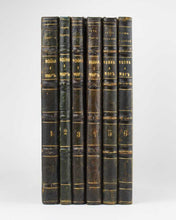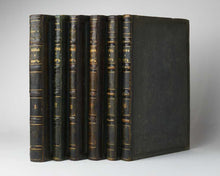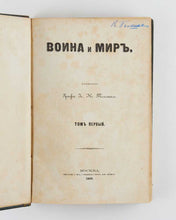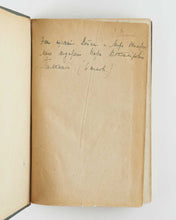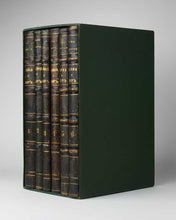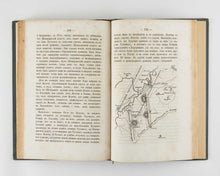
First edition, from the library of the Admiral’s daughter
TOLSTOY, Lev Nikolayevich. Война и мир [War and Peace]. Moscow: T. Ris [for the author] . 1868-1869.
Seven parts in six vols, 8vo. Contemporary Russian morocco-backed dark green cloth, blind-stamped border to covers, spine blind tooled in compartments, lettered directly in gilt (spine of vol. II with slight differences), green silk place-markers, housed in a modern custom-made slipcase; pp. I: [4], 297, [1 (blank)], 146; II: [4], 186, [2 (blank)]; III: [4], 284; IV: [4], 336; V: [4], 323, [1 (blank)]; VI: [4], 290, [2 (blank)]; each volume with half-title, in-text map at p. 239 of vol. IV; spine ends and corners expertly repaired, front endpapers of vol. IV and front free endpaper of vol. V renewed; variable light spotting, the odd stain, but overall a very good and remarkably fresh copy; ownership signature “N. Tomilova” to front free endpaper of vol. I; later signature “V[era] Pilkina” to title of vols I and IV; presentation inscription “This will be War and Peace by Tolstoy, my gift to Vera Vladimirovna Pilkina (6 volumes)” in ink to front free endpaper of vol. I (see below).
First edition, first issue of the masterpiece of Russian literature, often called “the greatest novel ever written”.
Written within a “European tradition in which the Napoleonic war had already acquired mythopoetic grandeur” (Aylmer Maude), War and Peace stands at once as war epic, philosophical meditation, and an exploration of the superiority of the “Russian spirit”. Lev Tolstoy’s creativity lies above all in the sheer abundance and vitality of his characters – a vast cast, yet each fully realised and unforgettable. From this immense tapestry emerges not only a sweeping chronicle of nations in conflict, but also a profound reflection on the individual’s role within the inexorable flow of history. Thomas Mann famously praised Tolstoy for his “Homeric powers”, placing War and Peace alongside the Iliad: “To read him … is to find one’s way home, safe from every danger of affectation and morbid trifling; home to originality and health, to everything within us that is fundamental and sane”.
A first draft of War and Peace was completed as early as 1863. Between 1865 and 1866, the first and second parts of volume one appeared in The Russian Messenger (in Russian: Русский вестник) under the title The Year 1805 (1805 год). Tolstoy, however, was dissatisfied with the initial version and undertook a complete rewrite, continuing revisions into the beginning of 1869. His wife, Sophia Tolstaya, copied out no fewer than seven full manuscripts before Tolstoy considered the work ready for publication. The novel was published at the author’s own expense: Tolstoy advanced 4,500 Rubles for an initial print run of 4,800 copies, on the agreement that the printer and proofreader would receive 30% of the gross profit. The venture proved an immediate success; retailing at 10 Rubles a copy, the book was greeted with rapturous reviews and entered a second edition before the first was entirely off the press. Even Ivan Turgenev – whose infamous quarrel with Tolstoy nearly led to a duel – admitted that War and Peace was one of the most remarkable books of its time.
Each of the original seven parts (the first volume being divided into two) was issued in yellow wrappers, with titles printed in black and red. Nevertheless, the binding of our copy is strictly contemporary, with each volume bound individually rather than two-by-two as is more commonly the case. It may in fact have been produced in connection with the publisher, since identical boards are found on another copy, held at the National Library of the Czech Republic.
Provenance: From the library of Vera Vladimirovna Pilkina (1910-1993), daughter of Rear Admiral Vladimir Konstantinovich Pilkin (1869-1950), officer of the Imperial Russian Navy and member of the White movement. Pilkin served in both the Russo-Japanese and First World wars, and during the Russian Civil War became naval Minister in the Northwestern Government under General Nikolai Nikolayevich Yudenich (1862-1933). Following the Whites’ defeat, he settled in Nice where he served as chairman of an association of Russian naval officers in exile. Vera Pilkina is buried in the Russian Cemetery of Nice.
Kilgour 1195
#2123105






